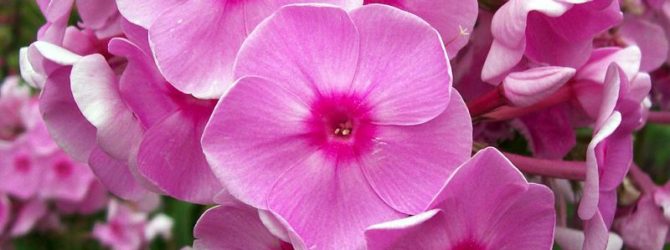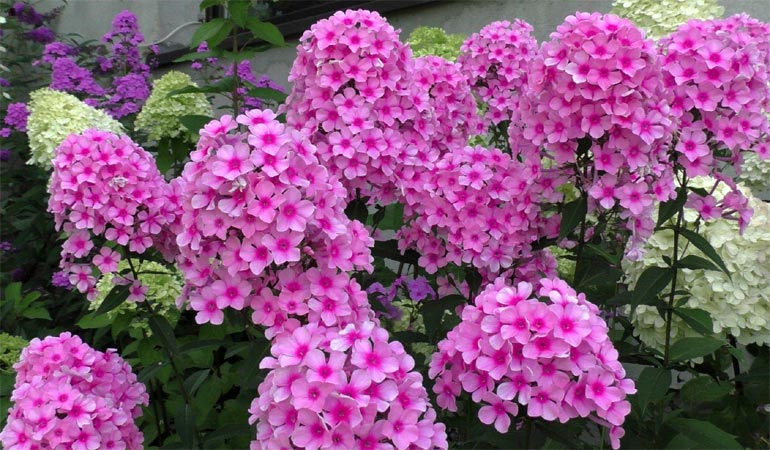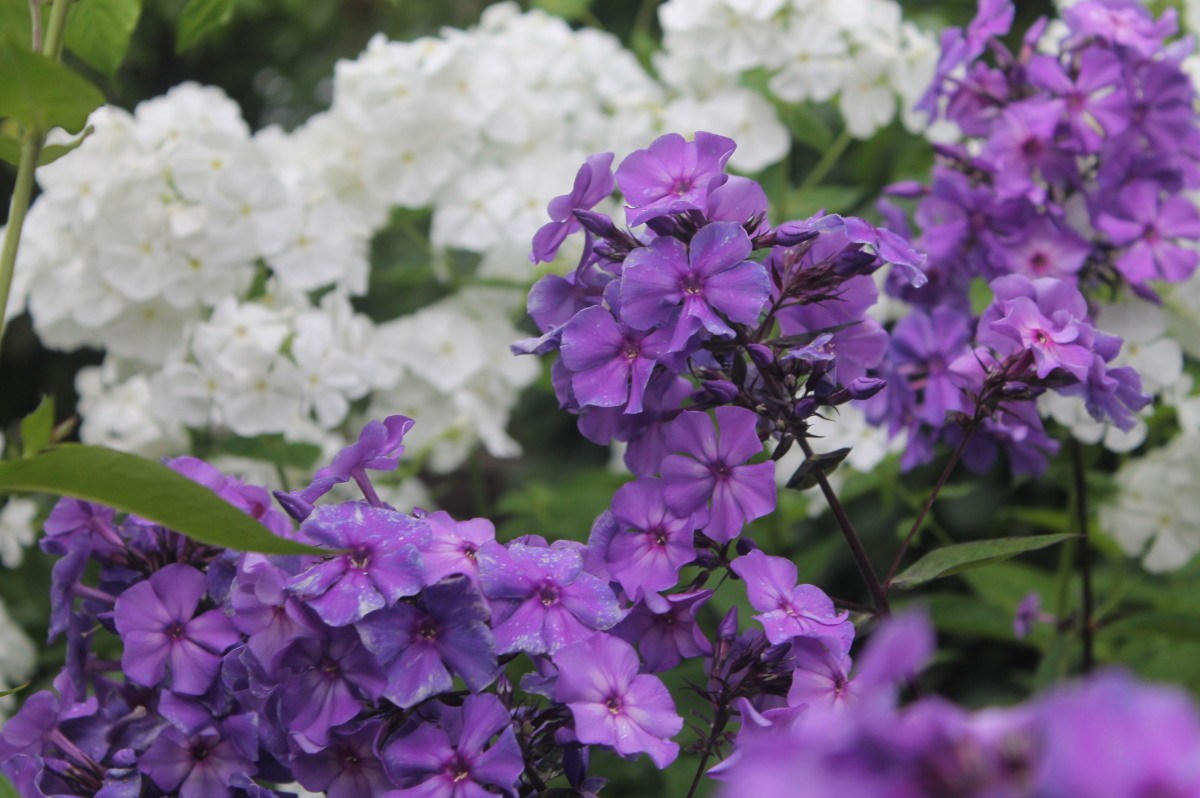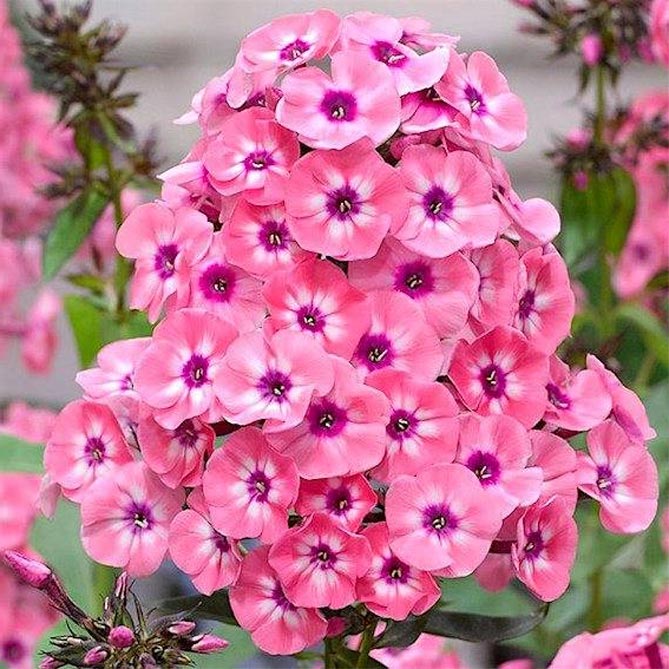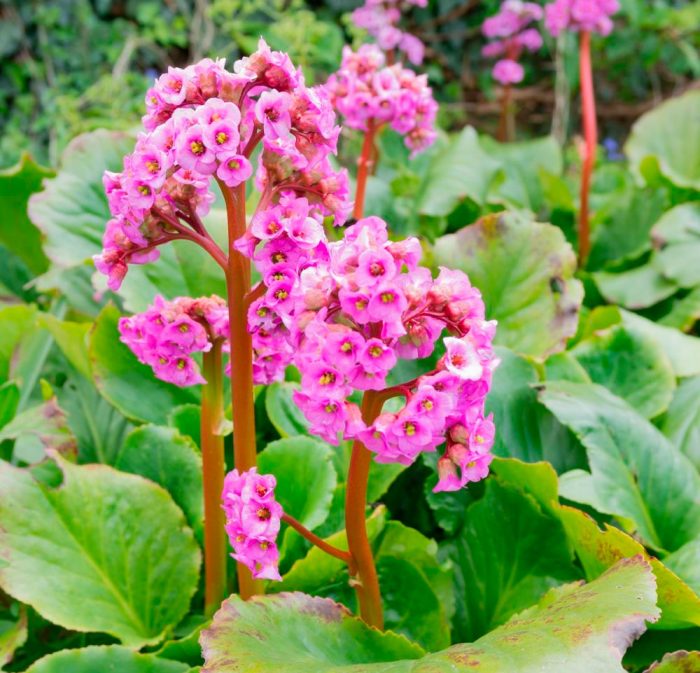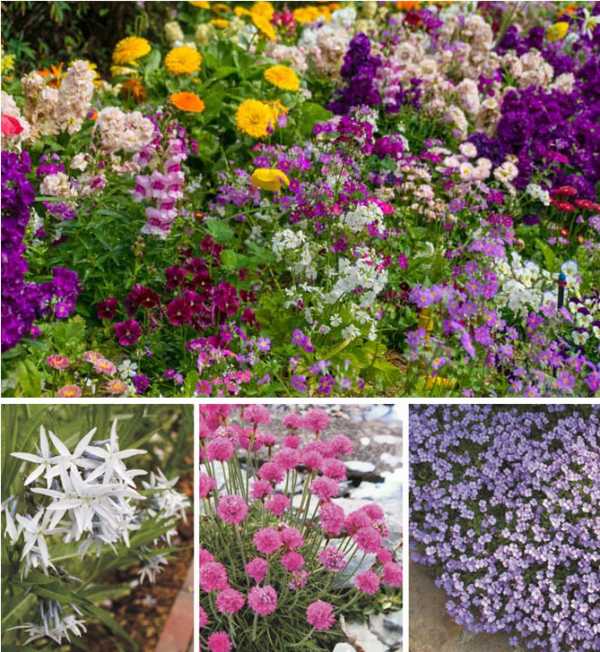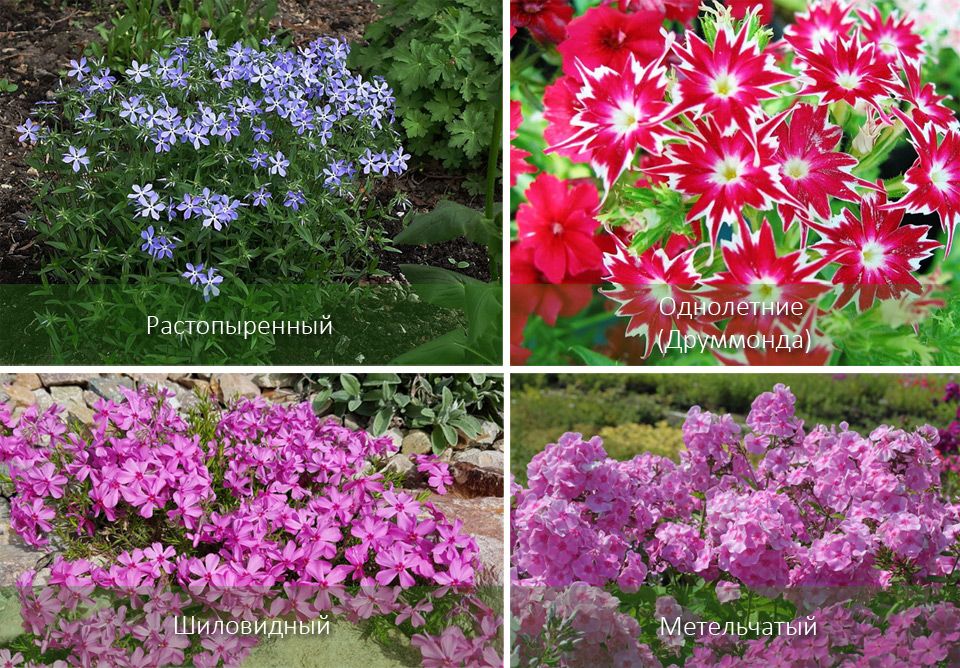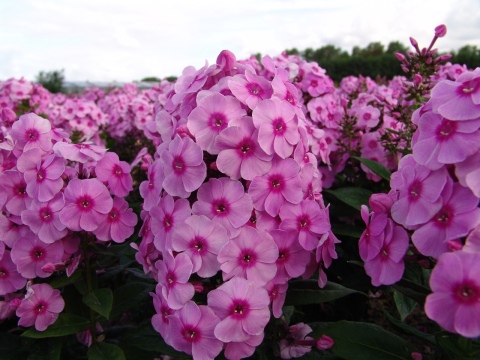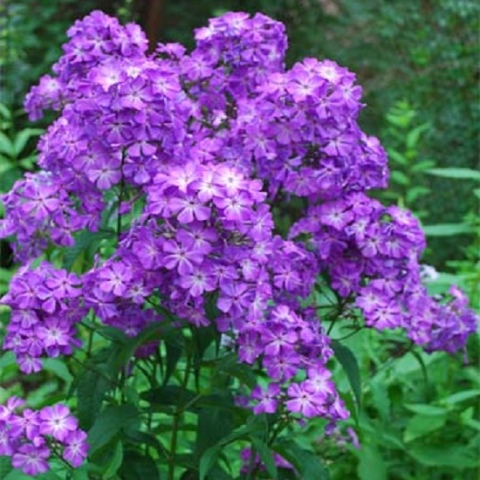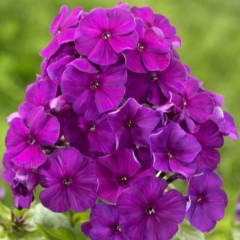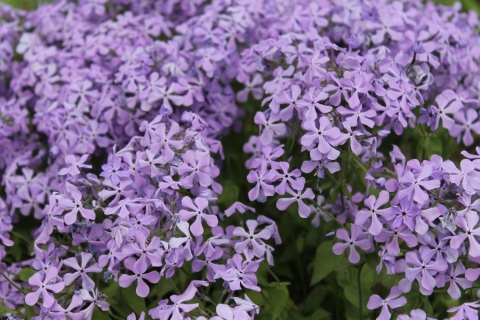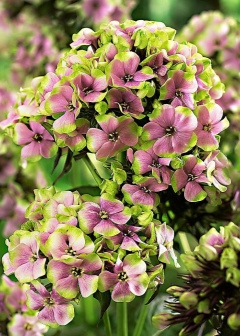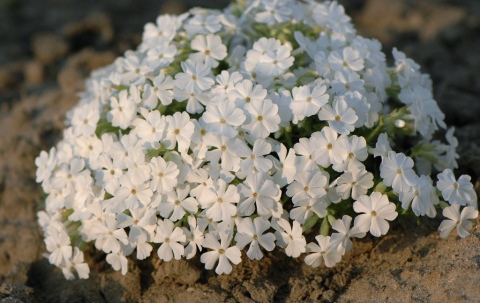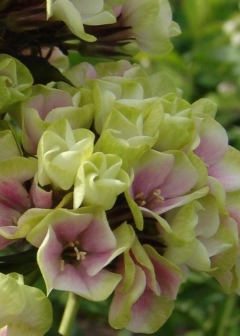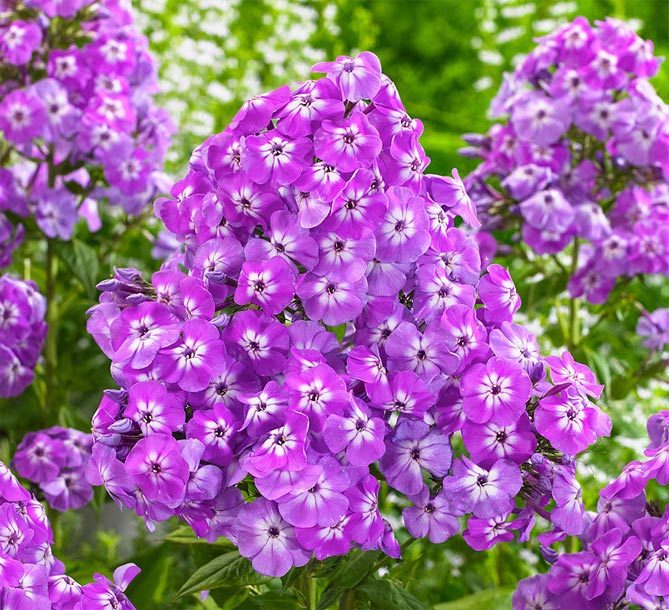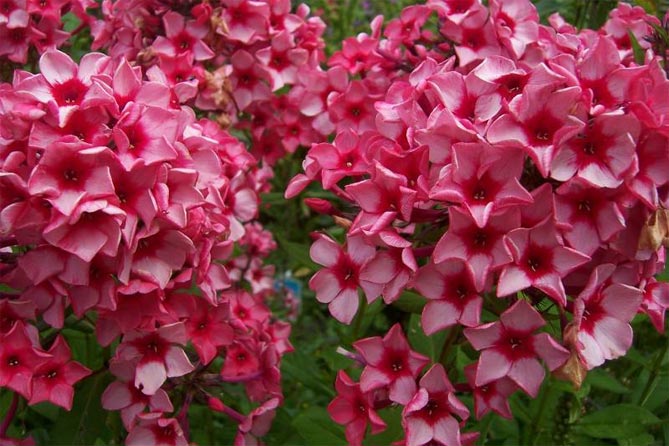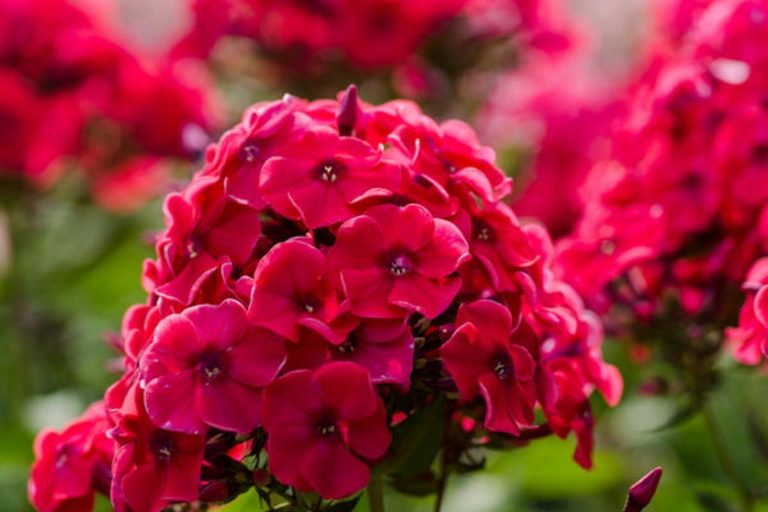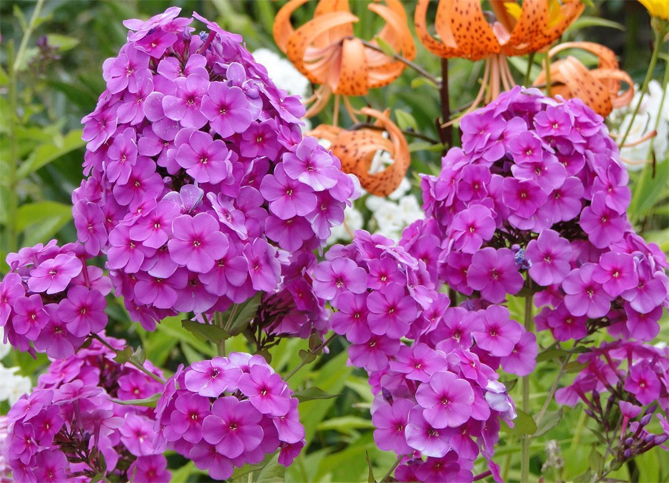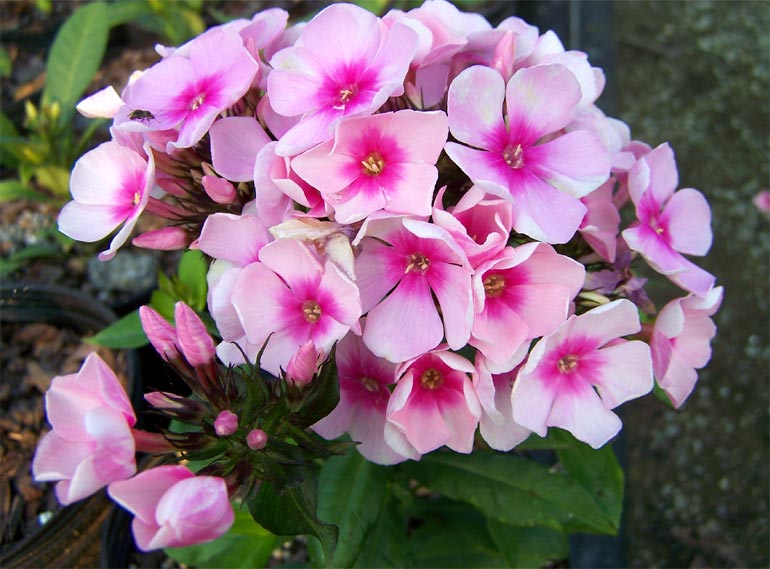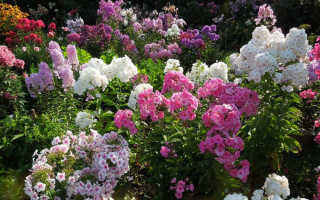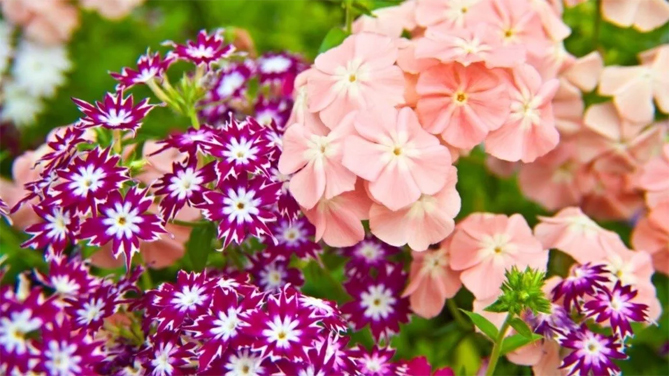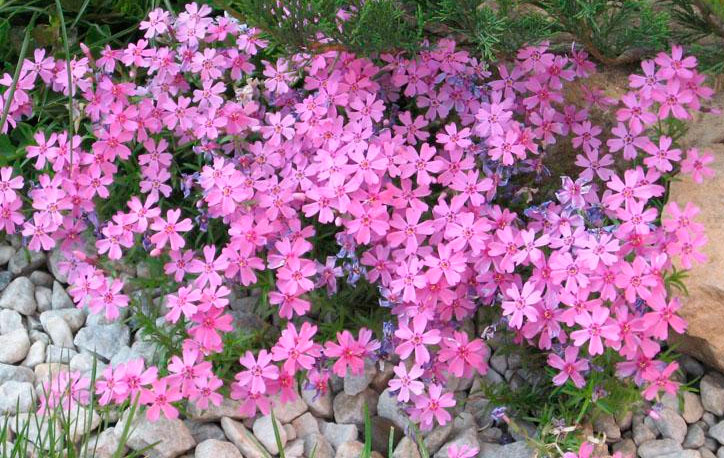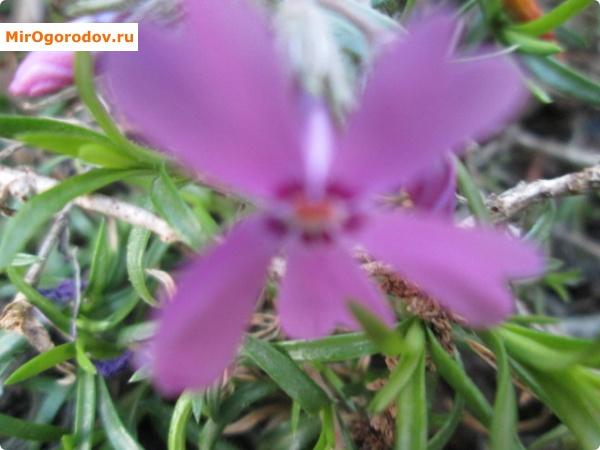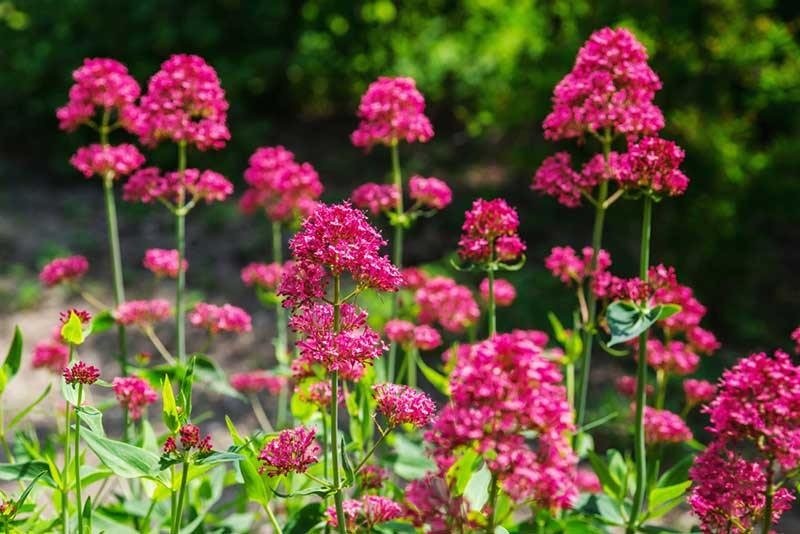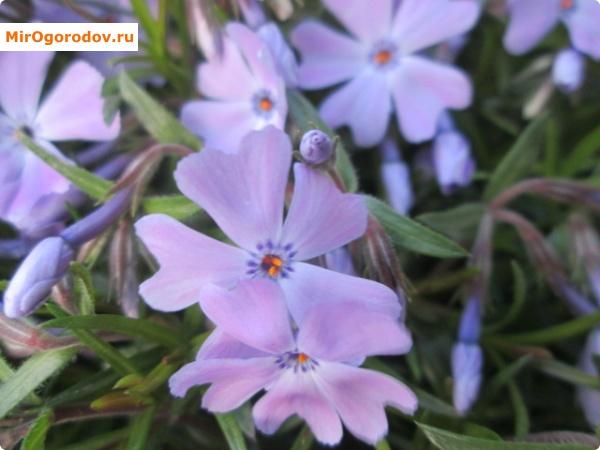Diseases and pests
Phlox disease is not threatened, if you take good care of them, do not start your landing. One of the most common diseases that spoils the appearance of this perennial is powdery mildew, which covers the leaves and stems with a white coating. This disease can overcome the plant in mid-July. If you do not take action, then the leaves affected by the disease will begin to dry out and fall off.
To avoid this disease, plants in October must be treated with one percent Bordeaux liquid or a solution of copper sulfate of the same concentration. At the beginning of summer, spray the plants with fungicidal preparations.
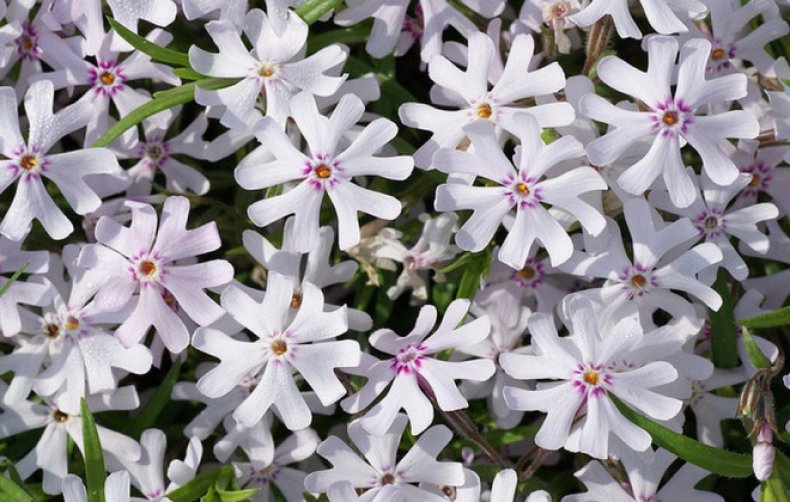
If you notice signs of a disease, namely a white bloom, then the plants must be treated with Bordeaux liquid. Re-processing is carried out after 7-10 days.
In addition, aphids are dangerous for plants, but they only attack weakened flowers. Therefore, do not allow food shortages and water them in time. Among the pests of phlox, the earwig, spider mite, and wireworm should also be noted.
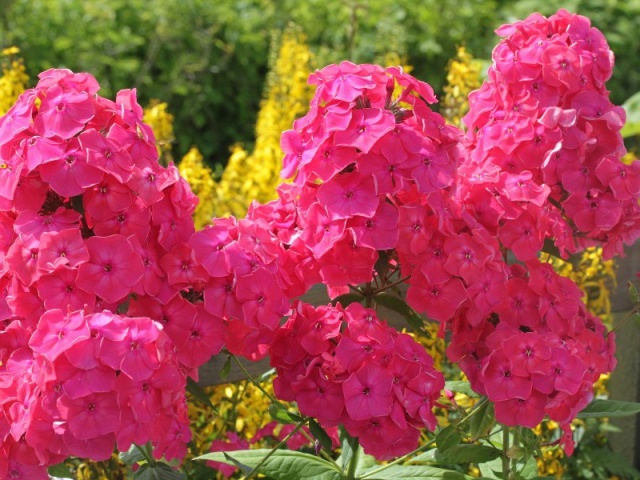
As you can see, this beautiful perennial plant does not cause any particular difficulties in care, does not require much attention from you. However, these bright, fragrant flowers can be the best garden decoration and a wonderful addition to your floral arrangement. They are very unassuming, at the same time they bloom very luxuriantly and profusely, especially if they are fed.
Phlox Nicky: care and reproduction
First of all, it is worth touching on the topic of plant care. Those who decide to acquire this flower must understand how to care for it, otherwise it will die almost immediately after planting. First of all, it is worth considering the fact that the flower loves an increased level of moisture. Due to the fact that the thin shoots of the root system, as a rule, are not located too deep in the soil (up to 15 cm), in no case should the soil completely dry out. In addition, a lack of moisture can negatively affect flowering. The flowers will become smaller and lethargic. It is considered optimal to water the plant every morning with 1.5-2 buckets.
It is important not to "run" the flowerbed, where Nicky phlox grows, because along with the appearance of weeds, the chance of developing various diseases and the appearance of pests also increases. With the arrival of the first frost, it is necessary to cut the bush to the very root, and treat the remaining root well with copper sulfate
The cut stems must be disposed of. Horticultural experts do not recommend thickening the bushes to avoid powdery mildew damage to the plant.
As for the methods of its reproduction, here the situation is a little more complicated. The easiest way to reproduce is by separating part of the roots from the mother plant. This should be done only in early autumn or spring, because it is at this time that young shoots begin to look out of the soil. As a rule, a delenka has several well-formed stems, which should be planted to a depth of no more than 4 cm.
You can also propagate this plant variety by cuttings. Dig up breeding material in early summer. Cuttings take root quite quickly (no longer than 30 days).
Less commonly, the method of rooting layers is used. This means that the stems must be bent straight to the ground and anchored to the ground. Then the hilling procedure is carried out with a mixture of humus and peat, and in the fall a full-fledged bush will grow from the resulting blank.
It is worth mentioning the propagation of the plant by planting Niki phlox seeds. This requires mandatory stratification. Exactly one month before planting plants in an open area, the seeds must be planted in seedling boxes. The last weeks of May are considered the best time for this procedure.Also, the soil must be prepared in advance: dug up, cleared of weeds, treated with fertilizers and moistened.
For more information on this phlox, see the next video.
Spread Phlox Varieties
The color of the varieties of the spreading phlox, in contrast to the paniculate, is not too diverse: it is a range of white, sky-blue, lilac tones. However, even these colors allow you to create very beautiful flower beds. For this, flower growers use popular varieties that are cultivated in culture.
Chattahoochee's Spread Phlox
Phlox Chattahoochee is a cultivar with delicate lilac flowers. The bushes are compact, undersized: up to 25 cm. Flowering begins at the end of May and lasts until the last decade of June. Flowers are five-petal, up to 4 cm in diameter. It is advisable to grow the crop in semi-shady places.
The lilac-pink core gives special attractiveness to the flowers of the splayed phlox.
Attention! This variety has good drought tolerance. Suitable for beginner florists.
Spread Phlox Variegata
The Phlox Variegata cultivar produces flowers of a light lilac color up to 2–2.5 cm in diameter. The leaves are variegated, with a dark green core and a light yellow edging. Forms dense thickets, densely covering the soil, the maximum height of the peduncles is 15 cm.
Variegata has attractive, delicate lilac flowers
Spread Phlox Clouds of Perfume
Variety Phlox Clouds of Perfume is a short shrub up to 30 cm. Flowers are bluish, lilac. They give a pleasant aroma, thanks to which the variety got its name, which can be translated as “clouds of perfume”.
Important! The variety is characterized by moderate winter hardiness: it can withstand frosts down to -29 ° C. Therefore, it is grown only in the middle lane, in the Black Earth Region and in the southern regions of Russia.
Clouds of Perfume is characterized not only by beautiful flowers, but also by a pleasant aroma.
Spread Phlox White Perfume
Spreading phlox White Perfume has white flowers up to 2 cm in diameter with a delicate "perfume" aroma. The bush is quite high - up to 40 cm. The leaves are narrow, up to 5 cm long, hard. The variety is very fond of moisture - during drought, its flowering is reduced.
White flowers White Perfume create a pleasant spring background in the flowerbed and in mixborders
Spread Blue Moon Phlox
Phlox Blue Moon is a variety whose name translates as "blue moon". The bush is small, up to 20 cm high, and the inflorescences are large: up to 4 cm in diameter. They emit a very pleasant aroma. This variety of splayed phlox (pictured) has flowers in an attractive blue color.
The Blue Moon variety is often used in single plantings on manicured lawns.
Split phlox Blue Dream
Phlox Blue Dream is a well-growing bush with lavender-blue, light lilac flowers. It grows up to 30 cm, completely covers the soil.
Delicate lilac flowers of the Blue Dreams variety exude a pleasant aroma
May Breeze
Phlox May Breeze ("May breeze") - a plant up to 40 cm high. Gives soft lilac, bluish flowers up to 5 cm in diameter. They give a pleasant "spring" scent. The May Breeze variety looks good in mixborders, it is often used for planting near a reservoir and in a rock garden.
May Breeze splayed phlox withstands winter frosts down to -34 ° C
Fullers White
Phlox Fullers White is a snow-white flower up to 3 cm in diameter. It gives a very pleasant honey aroma that distinguishes this variety from the rest. Suitable for both garden decoration and cutting.
Benefits of Spreading Phlox Fullers White - snow-white flowers with a honey scent and pleasant juicy greens
Digiro Ice
Phlox Dirigo Ice is one of the lighter varieties. Flowers of an unusual pastel blue, cream shade. At the same time, the foliage is light green, which creates a very pleasant combination.
The Digiro Ice variety looks very elegant thanks to its original color scheme.
Montrose Tricolor
This variety of spreading phlox, Phlox Montrose Tricolor, is popular with the gardener for its lavender flowers with a purple core. Stems are flexible, thin, spread along the ground. Not only inflorescences are decorative, but also the leaves: they are painted in a rich green color, have a white edging with shades of pale pink. That is why the variety was named "Tricolor". The combination of three shades at once creates a kind of "exotic" atmosphere.
The Montrose Tricolor variety is used both for garden decoration and for cutting.
Phlox after flowering
Annual phloxes may bloom next year, but the quality of the inflorescences is unlikely to be high. Therefore, collect, if you like, seeds, cut off the tops that have dried up in the fall, and dig up the ground on the site, removing phlox rhizomes from it. In the spring you can sow the collected seeds, and the flowers you like will bloom again.
In the photo: Blooming phlox in the garden
Phlox wintering
Perennial phlox, or rather, their growth buds in a snowless winter can freeze out if the temperature drops to -10-15 ºC, and if the frost reaches -20-25 ºC, the phlox rhizome will die. Therefore, in the fall, after the phlox tops have turned yellow and dried, cut it off, and sprinkle the root collars with a layer of soil with peat. Cover them with straw, fallen leaves, or spruce branches to keep the roots in the soil until spring. If snow falls 50-60 cm thick, then you can not be afraid of thirty-degree frosts.
Overview of species and best varieties
In landscape design and gardening, both artificially obtained forms and varieties of phlox and their wild species are popular. Breeding work with many natural phlox species continues to this day.
Panicled phlox is one of the most famous representatives of its genus. The natural habitat of this herbaceous perennial is the southeast of North America. In the wild, the plant prefers to grow in places with well-moistened soil - in floodplains of rivers, damp forest lowlands. The height of paniculate phlox ranges from 0.6 to 1.5 m. Plants form strong bushes with erect, smooth stems with a lignified base.
Leaves are lanceolate, rounded, reaching 7-15 centimeters in length. Flowers are small, numerous, collected in loose panicles. The palette of colors includes milky white, pale pink, lavender-lilac and other shades. The approximate flowering time is July-September.
Flowers appear in June. The color of the flowers can be snow-white, pinkish-purple, lilac-purple.
Below are descriptions of the most popular varieties of phlox of foreign and domestic selection.
The size of the flowers varies from 3 to 4 centimeters. The color of the flowers is piercing pink with a slight lilac tint. The core of the flower is decorated with a white star-shaped spot.
The flowers are large (up to 4 centimeters), sky-blue in color with light purple-violet strokes on the petals. Indoors and at dusk, the flowers appear turquoise blue. The center of the flowers is decorated with a lilac-purple star-shaped spot.
Flowering time is early summer. During this period, the plants form many small corymbose inflorescences. The flowers are small, simple, five-petal, of a delicate amethyst color with a slight lilac tint.
Flowering begins in early spring. At this time, the plants are covered with numerous caps of corymbose inflorescences. The flowers are small, pale lilac in color, with a purple-crimson center.
Description
Many species of phlox are known throughout the world. More than forty species have been domesticated. And there are several hundred varieties and hybrids. In the wild, it grows on rocky slopes and in crevices, sandy hills. You can also find it in the shade of bushes, if the place is well lit.

The plant is a spreading bushes covered with narrow, elongated and pointed leaves.
Loose or dense sod, which forms the root system of the plant, are able to quickly build up volume. Before flowering, the cushion of the bush (resembles a bump of moss) in height can reach only 8-10 centimeters. Further, small peduncles appear, on which up to two corollas are located, collected in inflorescences.
The height of the bush becomes 15-20 centimeters.
Umbrellas of inflorescences contain up to 7-8 flowers, they can be single. Their diameter is 2.5-3 centimeters.Phlox petals have different shades of color, similar to candy canes, they are deeply cut or resemble a heart shape.
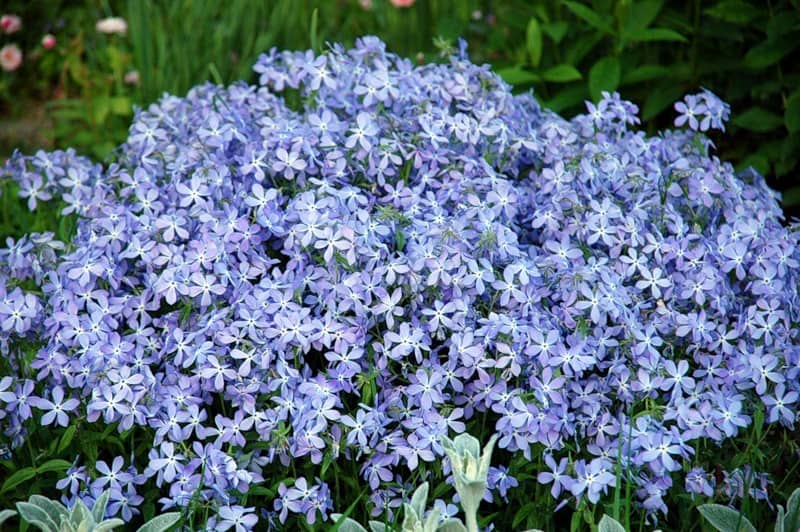
Creeping phlox, with leaves in the form of an awl, are very fond of summer residents. These flowers are renowned for their numerous varieties, which delight in a magnificent variety. Long flowering (from mid-May to September), sometimes twice a season, only adds to the popularity.
Botanical description of the species
Phlox paniculata (Phlox paniculata) is a perennial herb 35-150 cm tall. Most varieties form bushes with a height of 60-70 or 80-100 cm. It must be remembered that this parameter changes, depending on the light intensity. In the bright sun, the plants turn out lower, but even a two-hour midday shade increases their height. Stems are very strong, straight, woody by the end of the growing season.
There is no yellow in the phlox paniculata color palette. This pigment is also absent in the group of so-called red varieties. Their color is dominated by crimson color of different saturation, both warm and cold tones. Therefore, in the descriptions there are definitions such as red-pink, red-purple, light orange-red, purple-red, etc. The situation is similar in the group of orange, or salmon. These tones are very peculiar and complex, they also come in different intensities with the addition of pink and carmine.

